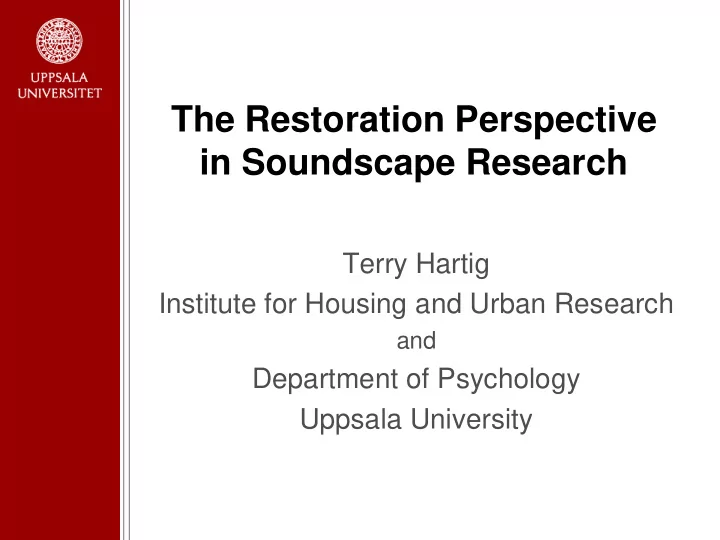

The Restoration Perspective in Soundscape Research Terry Hartig Institute for Housing and Urban Research and Department of Psychology Uppsala University
Restoration … … is a process of renewing or recovering a resource or capacity that has become depleted in meeting demands in everyday life.
Stress Coping Restoration Perspective Perspective Perspective Theoretical Heavy Readily Adaptation Premise demands can available requires undermine resources periodic adaptation. support restoration. adaptation. Practical Interventions Interventions Interventions Premise can eliminate can ensure the can enhance or mitigate availability of opportunities demands. resources. for restoration. From Hartig, Bringslimark, & Patil (2008); Hartig (2008).
The Restorative Environment … … is an environment that promotes (and not merely permits) restoration. … involves psychological mechanisms that evoke positive affects and/or engage effortless attention.
? ?
Practical Applications The restoration perspective directs attention to applications involving soundscapes that permit and/or promote restoration.
Restorative Soundscape Applications Permit Promote Restoration Restoration Protect Regulate noise Preserve valued sound Restorative sources and maintain sources and musical Environment norms of traditions silence. in places. Provide Mask unwanted Introduce pleasant and Restorative sounds that interesting Environment cannot be sounds, such eliminated. as music.
Applications in Theory and Research The restoration perspective suggests fruitful conceptual distinctions.
Noise as Stressor vs Constraint on Restoration Does some unwanted sound work against health because it taxes resources or because it hinders recovery of resources depleted in efforts to meet other demands?
Contributors to Chronic Stress 1. Persistent demands. 2. Inability to acquire new resources that would make it easy to deal with those demands. 3. Inability to more effectively apply available resources. 4. Inability to adequately restore depleted coping resources. From Hartig, Catalano, & Ong (2007)
Noise as a Stressor – A Traditional View Task in high-level noise and restoration in quiet Task and restoration in Stress level quiet Rest Rest Task Rest Task Task From Hygge, Hartig, & Time Kjellberg (2004).
Noise as a Constraint on Restoration Task and restoration in low level noise Task and restoration in quiet Stress level Rest Rest Task Rest Task Task From Hygge, Hartig, & Time Kjellberg (2004).
Distinguishing the Constraint of Restoration Outside of a context dedicated to restoration, the sound would have low salience and receive a neutral appraisal. Within a context dedicated to restoration, the sound would have high salience and annoy or irritate.
Community Noise as Constraint of Restoration Community noise regulations commonly assume a moderating effect of context on noise annoyance, in that they impose stricter controls on sound levels in locations and at times normally dedicated to restoration.
Types of Restoration Constraint Direct: unwanted sound reduces the restorative quality of the available activity/setting. Indirect: unwanted sound leads the person or group to choose a less restorative activity/setting.
Recapitulation The restoration perspective complements the stress and coping perspectives on adaptation. The restoration perspective suggests strategies for managing and changing soundscapes to protect and provide opportunities for restoration. The restoration perspective suggests a meaningful conceptual distinction between noise as stressor and noise as a constraint on restoration.
Thank you.
References Hartig, T. (2008). Green space, psychological restoration, and health inequality. Lancet, 372, 1614-1615. [invited comment] Hartig, T., Bringslimark, T., & Grindal Patil, G. (2008). Restorative environmental design: What, when, where, and for whom? In S. R. Kellert, J. Heerwagen, & M. Mador (Eds.), Bringing buildings to life: The theory and practice of biophilic building design (pp. 133-151). New York: Wiley. Hartig, T., Catalano, R., & Ong, M. (2007). Cold summer weather, constrained restoration, and the use of anti-depressants in Sweden. Journal of Environmental Psychology, 27, 107-116. Hygge, S., Hartig, T., & Kjellberg, A. (2004). Noise in nature – environmental stressor or constraint on restoration? Invited symposium on “Restoration and restorative environments,” 28th International Congress of Psychology, Beijing, China, August 8-13.
Recommend
More recommend